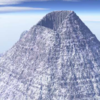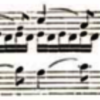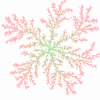 |
Li, Hua, David Mould, "Continuous Line Drawings On Dendrites", 6th International Conference on Digital Arts, 2012. [PDF]
[Show Abstract]
[Show Bibtex]
Continuous line drawing (CLD) is a drawing style where a picture consists of a single long closed line without self intersection. We present an algorithm for constructing CLDs from input images. We maintain the connectivity of the line through a tree generated by path finding with consideration of the key features for a given image. A branching tree structure is first grown incrementally by selecting pixels by a cost function, relating to both the tone map and an importance map. After labeling each branch, an artificial wall is then constructed through a two-stage labeling propagation process to produce a single boundary, interpreted as the final CLD. Our method is effective and automatic, and provides some opportunities for variations.
@inproceedings{Li:2012:CLD,
author = {Li, Hua and Mould, David},
title = {Continuous Line Drawings On Dendrites},
booktitle = {6th International Conference on Digital Arts},
year = 2012,
}
|
 |
Li, Hua, David Mould, "Content-sensitive Screening in Black and White", GRAPP, pp. 166-172, 2011. [PDF]
[Show Abstract]
[Show Bibtex]
Traditional methods produced unsatisfactory uniform screening. Often additional tones are added to improve the quality of tone and structure. In this paper, we try to produce screening with diverse patterns and with natural structure preservation while still using only one color of ink. We propose several extensions to contrast-aware halftoning including new weight distributions and variations on the priority-based scheme. Patterns can be generated by excluding pixels in a purposeful way and by organizing different groups of input edges based on user interest. Segmented regions are assigned different patterns, based on statistical measurements of the content of each region. Our method can automatically and efficiently produce effective screening with a lot of flexibility and without artifacts from segmentation or false edges.
@inproceedings{li11screening,
author = {Li, Hua and Mould, David},
title = {Content-sensitive Screening in Black and White},
booktitle = {GRAPP},
pages = {166--172},
year = 2011,
}
|
 |
Li, Hua, David Mould, "Structure-preserving Stippling by Priority-based Error Diffusion", Proceedings of Graphics Interface 2011, pp. 127-134, 2011. [PDF]
[Show Abstract]
[Show Bibtex]
This paper presents a new fast, automatic method for structure-aware stippling. The core idea is to concentrate on structure preservation by using a priority-based scheme that treats extreme stipples first and preferentially assign positive error to lighter stipples and negative error to darker stipples, emphasizing contrast. We also use a nonlinear spatial function to shrink or exaggerate errors and thus implicitly provide global adjustment of density. Our adjustment respects contrast and hence allows us to preserve structure even at a very low stipple budget. We also explore a variety of stylization effects, including screening and scratchboard, all within the unifying framework of stippling.
@inproceedings{Li:2011:SSP:1992917.1992938,
author = {Li, Hua and Mould, David},
title = {Structure-preserving Stippling by Priority-based Error Diffusion},
booktitle = {Proceedings of Graphics Interface 2011},
pages = {127--134},
year = 2011,
}
|
 |
Li, Hua, David Mould, "Artistic Tessellations by Growing Curves", Proceedings of the ACM SIGGRAPH/Eurographics Symposium on Non-Photorealistic Animation and Rendering, pp. 125-134, 2011. [PDF]
[Show Abstract]
[Show Bibtex]
In this paper we propose to tessellate a region by growing curves. We use a particle system, which flexibly provides good control over the final effects by variations of the initial placement, the placement order, curve direction, and curve properties. We also propose an automatic image-based mosaic method which has good texture indication, using a smoothed vector field to guide particle movement. The final irregular tessellation simulates stained glass and the elongated curved tiles faithfully express the large-scale flow in highly textured areas. We give some additional applications, some of which resemble naturally occurring irregular patterns such as cracks and scales. We also notice that stacking a set of curves in a structured way can give the illusion of a 3D shape.
@inproceedings{Li:2011:ATG:2024676.2024697,
author = {Li, Hua and Mould, David},
title = {Artistic Tessellations by Growing Curves},
booktitle = {Proceedings of the ACM SIGGRAPH/Eurographics Symposium on Non-Photorealistic Animation and Rendering},
pages = {125--134},
year = 2011,
}
|
 |
M, Regan L. ryk, David Mould, Hua Li, "Evaluation of Emotional Response to Non-photorealistic Images", Proceedings of the ACM SIGGRAPH/Eurographics Symposium on Non-Photorealistic Animation and Rendering, pp. 7-16, 2011. [PDF]
[Show Abstract]
[Show Bibtex]
Non-photorealistic rendering (NPR) algorithms are used to produce stylized images, and have been evaluated on the aesthetic qualities of the resulting images. NPR-produced images have been used for aesthetic and practical reasons in media intended to produce an emotional reaction in a consumer (e.g., computer games, films, advertisements, and websites); however, it is not understood how the use of these algorithms affects the emotion portrayed in an image. We conducted a study of subjective emotional response to five common NPR approaches, two blurring techniques, and the original image with 42 participants, and found that the NPR algorithms dampened participants' emotional responses in terms of arousal (activation) and valence (pleasure).
@inproceedings{Mandryk:2011:EER:2024676.2024678,
author = {Mandryk, Regan L. and Mould, David and Li, Hua},
title = {Evaluation of Emotional Response to Non-photorealistic Images},
booktitle = {Proceedings of the ACM SIGGRAPH/Eurographics Symposium on Non-Photorealistic Animation and Rendering},
pages = {7--16},
year = 2011,
}
|
 |
Carmichael, G., R. Laganiere, P. Bose, "Global Context Descriptors for SURF and MSER Feature Descriptors", Computer and Robot Vision (CRV), pp. 309-316, 2010. [DOI]
[Show Abstract]
[Show Bibtex]
Global context descriptors are vectors of additional information appended to an existing descriptor, and are computed as a log-polar histogram of nearby curvature values. These have been proposed in the past to make Scale Invariant Feature Transform (SIFT) matching more robust. This additional information improved matching results especially for images with repetitive features. We propose a similar global context descriptor for Speeded Up Robust Features (SURFs) and Maximally Stable Extremal Regions (MSERs). Our experiments show some improvement for SURFs when using the global context, and much improvement for MSER.
@inproceedings{carmichael10descriptors,
author = {Carmichael, G. and Laganiere, R. and Bose, P.},
title = {Global Context Descriptors for SURF and MSER Feature Descriptors},
booktitle = {Computer and Robot Vision (CRV)},
pages = {309--316},
year = 2010,
}
|
 |
Xu, Ling, David Mould, "A Hybrid Image-Based Method to Generate Sketching Portrait", Graphics Interface 2010 Poster Session, 2010. [Show Bibtex]
@inproceedings{Xu:2010:AHIB,
author = {Xu, Ling and Mould, David},
title = {A Hybrid Image-Based Method to Generate Sketching Portrait},
booktitle = {Graphics Interface 2010 Poster Session},
year = 2010,
}
|
 |
Xu, Ling, David Mould, "Constructive Path Planning for Natural Phenomena Modeling", GRAND Annual Conference 2010 Poster Session, 2010. [Show Bibtex]
@inproceedings{Xu:2010:CPPN,
author = {Xu, Ling and Mould, David},
title = {Constructive Path Planning for Natural Phenomena Modeling},
booktitle = {GRAND Annual Conference 2010 Poster Session},
year = 2010,
}
|
 |
Li, Hua, David Mould, "Contrast-Aware Halftoning.", Eurographics, 2010. [PDF]
[Show Abstract]
[Show Bibtex]
This paper proposes two variants of a simple but efficient algorithm for structure-preserving halftoning. Our algorithm extends Floyd-Steinberg error diffusion; the goal of our extension is not only to produce good tone similarity but also to preserve structure and especially contrast, motivated by our intuition that human perception is sensitive to contrast. By enhancing contrast we attempt to preserve and enhance structure also. Our basic algorithm employs an adaptive, contrast-aware mask. To enhance contrast, darker pixels should be more likely to be chosen as black pixels while lighter pixels should be more likely to be set as white. Therefore, when the positive error is diffused to nearby pixels in a mask, the dark pixels absorb less error and the light pixels absorb more. Conversely, negative error is distributed preferentially to dark pixels. We also propose using a mask with values that drop off steeply from the centre, intended to promote good spatial distribution. It is a very fast method whose speed mainly depends on the size of the mask. But this method suffers from distracting patterns. We then propose a variant on the basic idea which overcomes the first algorithm's shortcomings while maintaining its advantages through a priority-aware scheme. Rather than proceeding in random or raster order, we sort the image first; each pixel is assigned a priority based on its up-to-date distance to black or to white, and pixels with extreme intensities are processed earlier. Since we use the same mask strategy as before, we promote good spatial distribution and high contrast. We use tone similarity, structure similarity, and contrast similarity to validate our algorithm. Comparisons with recent structure-aware algorithms show that our method gives better results without sacrificing speed.
@inproceedings{LiM:10:CAH,
author = {Li, Hua and Mould, David},
title = {Contrast-Aware Halftoning.},
booktitle = {Eurographics},
year = 2010,
}
|
 |
Rusnell, Brennan, David Mould, Mark Eramian, "Feature-rich Distance-based Terrain Synthesis", The Visual Computer, vol. 25, n. 5-7, pp. 573-579, 2009. [PDF]
[Show Abstract]
[Show Bibtex]
This paper describes a novel terrain synthesis method based on distances in a weighted graph. A height field is determined by least-cost paths in a weighted graph from a set of generator nodes. The shapes of individual terrain features, such as mountains, hills, and craters, are specified by a monotonically decreasing profile describing thecross-sectional shape of a feature. The locations of features in the terrain are specified by placing the generators; secondary ridges are placed by pathing. We show the method to be robust and easy to control, even making it possible to embed images in terrain shadows. The method can produce a wide range of realistic synthetic terrains such as mountain ranges, craters, cinder cones, and hills. The ability to manually place terrain features that incorporate multiple profiles produces heterogeneous terrains that compare favorably to existing methods.
@article{Rusnell:2009:FDT:1536170.1536185,
author = {Rusnell, Brennan and Mould, David and Eramian, Mark},
title = {Feature-rich Distance-based Terrain Synthesis},
journal = {The Visual Computer},
volume = {25},
number = {5-7},
pages = {573--579},
year = 2009,
}
|
 |
Long, Jeremy, David Mould, "Dendritic Stylization", The Visual Computer, vol. 25, n. 3, pp. 241-253, 2009. [PDF]
[Show Bibtex]
@article{Long:2009:DS:1501934.1501938,
author = {Long, Jeremy and Mould, David},
title = {Dendritic Stylization},
journal = {The Visual Computer},
volume = {25},
number = {3},
pages = {241--253},
year = 2009,
}
|
 |
Rudolf, Dave, David Mould, "An Interactive Fluid Model of Jellyfish for Animation.", VISIGRAPP, pp. 59-72, 2009. [PDF]
[Show Abstract]
[Show Bibtex]
We present an automatic animation system for jellyfish that is based on a physical simulation.We model the thrust of an adult jellyfish, and the organism's morphology in its most active mode of locomotion.We reduce our model by considering only species that are axially symmetric so that we can approximate the full 3D geometry of a jellyfish with a 2D simulation. We simulate the organism's elastic volume with a spring-mass system, and the surrounding sea water using the semi-Lagrangian method. We couple the two representations with the immersed boundary method. We propose a simple open-loop controller to contract the swimming muscles of the jellyfish. A 3D rendering model is extrapolated from our 2D simulation. We add variation to the extrapolated 3D geometry, which is inspired by empirical observations of real jellyfish. The resulting animation system is efficient with an acceptable compromise in physical accuracy.
@inproceedings{RudolfM09,
author = {Rudolf, Dave and Mould, David},
title = {An Interactive Fluid Model of Jellyfish for Animation.},
booktitle = {VISIGRAPP},
pages = {59--72},
year = 2009,
}
|
 |
Smith, Jeff, David Mould, Mark Daley, "Constructures: supporting human ingenuity in software", Digital Creativity, 2009. [Show Abstract]
[Show Bibtex]
Existing media authoring software programs are generally regarded as offering little support for the earliest stages of the creative process, which have characteristics and needs that are distinct from the later stages. As a step toward addressing this, we present our constructural design philosophy: a set of principles that can be applied to software in any creative medium and under which we believe effective, early-stage creativity tools can be created. We then illustrate the application of these principles with Wheelsong, a complete, constructurally designed, early-stage music composition exploratorium and discuss a selection of musical sketches resulting from its use.
@article{Smith:2009:CSHI,
author = {Smith, Jeff and Mould, David and Daley, Mark},
title = {Constructures: supporting human ingenuity in software},
journal = {Digital Creativity},
year = 2009,
}
|
 |
Xu, Ling, David Mould, "Magnetic Curves: Curvature-controlled Aesthetic Curves Using Magnetic Fields", Proceedings of the Fifth Eurographics Conference on Computational Aesthetics in Graphics, Visualization and Imaging, pp. 1-8, 2009. [PDF]
[Show Bibtex]
@inproceedings{Xu:2009:MCC:2381286.2381288,
author = {Xu, Ling and Mould, David},
title = {Magnetic Curves: Curvature-controlled Aesthetic Curves Using Magnetic Fields},
booktitle = {Proceedings of the Fifth Eurographics Conference on Computational Aesthetics in Graphics, Visualization and Imaging},
pages = {1--8},
year = 2009,
}
|
 |
Mould, David, Kevin Grant, "Stylized Black and White Images from Photographs", Proceedings of the 6th International Symposium on Non-photorealistic Animation and Rendering, pp. 49-58, 2008. [PDF]
[Show Bibtex]
@inproceedings{Mould:2008:SBW:1377980.1377991,
author = {Mould, David and Grant, Kevin},
title = {Stylized Black and White Images from Photographs},
booktitle = {Proceedings of the 6th International Symposium on Non-photorealistic Animation and Rendering},
pages = {49--58},
year = 2008,
}
|
 |
Carmichael, Gail, "Girls, computer science, and games", ACM SIGCSE Bull., vol. 40, n. 4, pp. 107-110, 2008. [PDF]
[Show Abstract]
[Show Bibtex]
An innovative week long mini-course for girls has successfully used video game development as the main motivation by teaching related computer science topics at the same time. Students split their time between creating their own game in the lab and learning about game design, usability, graphics, and artificial intelligence. They became more comfortable with the subject and say they are more likely to pursue computer science in high school because of this course.
@article{Carmichael:2008:GCS:1473195.1473233,
author = {Carmichael, Gail},
title = {Girls, computer science, and games},
journal = {ACM SIGCSE Bull.},
volume = {40},
number = {4},
pages = {107--110},
year = 2008,
}
|
 |
Ling Xu, David Mould, "Constructive Path Planning for Natural Phenomena Modeling", International Conference on Computer Graphics and Artificial Intelligence, 2008. [Show Bibtex]
@inproceedings{xu08constructive,
author = {Ling Xu and David Mould},
title = {Constructive Path Planning for Natural Phenomena Modeling},
booktitle = {International Conference on Computer Graphics and Artificial Intelligence},
year = 2008,
}
|
 |
Mould, David, "Stipple Placement Using Distance in a Weighted Graph", Proceedings of the Third Eurographics Conference on Computational Aesthetics in Graphics, Visualization and Imaging, pp. 45-52, 2007. [PDF]
[Show Abstract]
[Show Bibtex]
We present a stipple placement method which provides extra emphasis to image features, especially edges. Our algorithm transforms an image into a regular graph, with edge weights given by the local gradient magnitude of the input image. Then, a variant of Disjkstra's algorithm is used to place stipples: new stipples are placed along the frontier, which tends to be aligned with image edges. The resulting stipple distribution approximates a blue noise distribution, but emphasizes edges from the input image. We also show how irregular mosaics can be organized and the mosaic tiles shaped using the same underlying mechanism.
@inproceedings{Mould:2007:SPU:2381255.2381262,
author = {Mould, David},
title = {Stipple Placement Using Distance in a Weighted Graph},
booktitle = {Proceedings of the Third Eurographics Conference on Computational Aesthetics in Graphics, Visualization and Imaging},
pages = {45--52},
year = 2007,
}
|
 |
Long, Jeremy, David Mould, "Improved Image Quilting", Proceedings of Graphics Interface, pp. 257-264, 2007. [PDF]
[Show Abstract]
[Show Bibtex]
In this paper, we present an improvement to the minimum error boundary cut, a method of shaping texture patches for nonparametric texture synthesis from example algorithms such as Efros and Freeman's Image Quilting. Our method uses an alternate distance metric for Dijkstra's algorithm, and as a result we are able to prevent the path from taking shortcuts through high cost areas, as can sometimes be seen in traditional image quilting. The resulting artifacts tend to be less pronounced than those created using the traditional cumulative distance metric. Post-process methods such as pixel re-synthesis can easily be modified and applied to our minimum error boundary cut to increase the quality of the results. This technique is not only useful for texture synthesis, but also seems promising for applications such as Wang Tiles or other contexts in which the minimum error boundary cut is applied.
@inproceedings{Long:2007:IIQ:1268517.1268559,
author = {Long, Jeremy and Mould, David},
title = {Improved Image Quilting},
booktitle = {Proceedings of Graphics Interface},
pages = {257--264},
year = 2007,
}
|
 |
Xu, Ling, David Mould, "Modeling Dendritic Shapes-Using Path Planning", International Conference on Computer Graphics Theory and Applications (GRAPP), pp. 29-36, 2007. [PDF]
[Show Bibtex]
@inproceedings{Xu:2007:MDS,
author = {Xu, Ling and Mould, David},
title = {Modeling Dendritic Shapes-Using Path Planning},
booktitle = {International Conference on Computer Graphics Theory and Applications (GRAPP)},
pages = {29--36},
year = 2007,
}
|




















